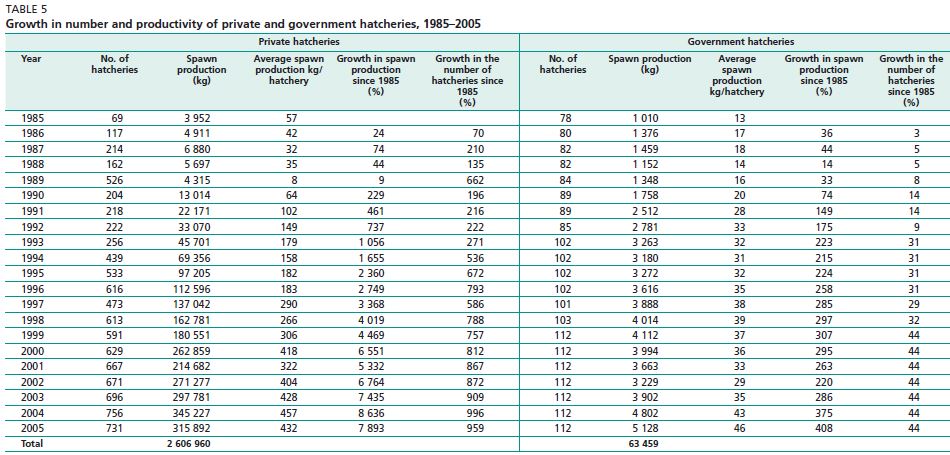RECOMMENDATIONS, REFERENCES
RECOMMENDATIONS
• Identify all the major carp natural breeding grounds both inside and outside Bangladesh through scientific investigations, and delineate them for future protection and enhancement of habitats.
• Obtain data on each natural major carp spawn collection center, investigate and update and map their biophysical and socioeconomic attributes (for example where they harvest and when, types and numbers of nets, quantity and quality

of spawn caught, how many people are engaged, who they are, what do they do, income and expenditure in spawn fishing, marketing and transportation).
• Undertake research to improve the spawn collection systems and techniques to reduce anthropogenic (human-induced) mortality and improve rearing and transportation systems.
• Identify the current barriers and constraints to the carp spawn fishery in the wild, especially regarding overwintering and migration of broodstock, morphological aspects of habitats (especially in the Halda River) in the context of water control structures, and suggest measures to overcome these barriers.
• Conduct socioeconomic studies of the people engaged in major spawn fishing in the wild and suggest alternative livelihood options to reduce pressure on this fragile and sensitive major carp spawn fishery.
• Ensure that existing sluice gates/water control regulators are operated in a manner that would facilitate fish and larval migration from rivers to floodplains and vice versa.
• Establish closed areas and seasons to allow major carp broods to migrate to their spawning grounds and spawn successfully.
• Declare and delineate carp sanctuaries in the wild, as has been established in the for the hilsa (river Shad) fishery in the Meghna River and its tributaries.
• Reduce and restrict the dependence of aquaculture on wild spawn through the improvement of hatchery production systems.
• Reexamine and update fisheries rules relating to spawn fishing from the wild, in order to facilitate natural replenishment of wild stock of fish including major carps.
REFERENCES
Alikunhi, K.H. 1957. Fish culture in India. Bull. Ind. Coun. Agri. Res., (2) 144 pp. Azadi, M.A. 1985. Spawning of commercial freshwater fish and marine and brackish water shrimps of Bangladesh. Fisheries Information Bulletin, BFRSS, Vol. 2. No. 2.
Hye, M.A. 1983. Fishery potential of Kaptai Lake. ADAB News, 10(6): 2–6.
Jhingran, V.G. 1983. Fish and fisheries of India. Hind. Publ., New Delhi, India. Kumar, D. 1992. Fish culture in undrainable ponds. A manual for extension. FAO Fisheries Technical Paper No. 325. Rome, FAO, 239 p.
Paul, N.C. 1997. Open water fisheries in the region of Bangladesh. In: Tsai, C. and Ali, Y.M. (eds). Openwater Fisheries of Bangladesh. UPL, Dhaka. pp. 173–182.
Shaha, M.S. & Haque, A.K.M.A. 1976. Qualitative and quantitative study of samples of fry and fingerlings of major carps from the river of old Brammaputra at Mymenshingh, M.Sc. Thesis, Dept.of Fishery Biol. and Limno. Bangladesh Agriculture Univ. 53 pp.
Tsai, C. & Ali, L. 1985. Open water fisheries (carp) management programme in Bangladesh. Bgd. Fish. Inf. Bull., 2(4): 51 pp.
Tsai, C. & Ali, L. 1986. Carp spawn fishery in the Padma (Ganges)-Brahmaputra river system, Bangladesh. Indian J. Fish., 33(4): 386–401.
Tsai, C. & Ali, L. 1987. The changes in fish community and major carp population in beels in the Sylhet-Mymenshing Basin, Bangladesh. Indian J. Fish., 34(1): 78–88.
Tsai, C., Islam, M.N., Karim, M.R. & Rahman, K.U.M.S. 1981. Spawning of major carps in the Lower Halda River, Bangladesh. Estuaries, 4(2): 127–138.